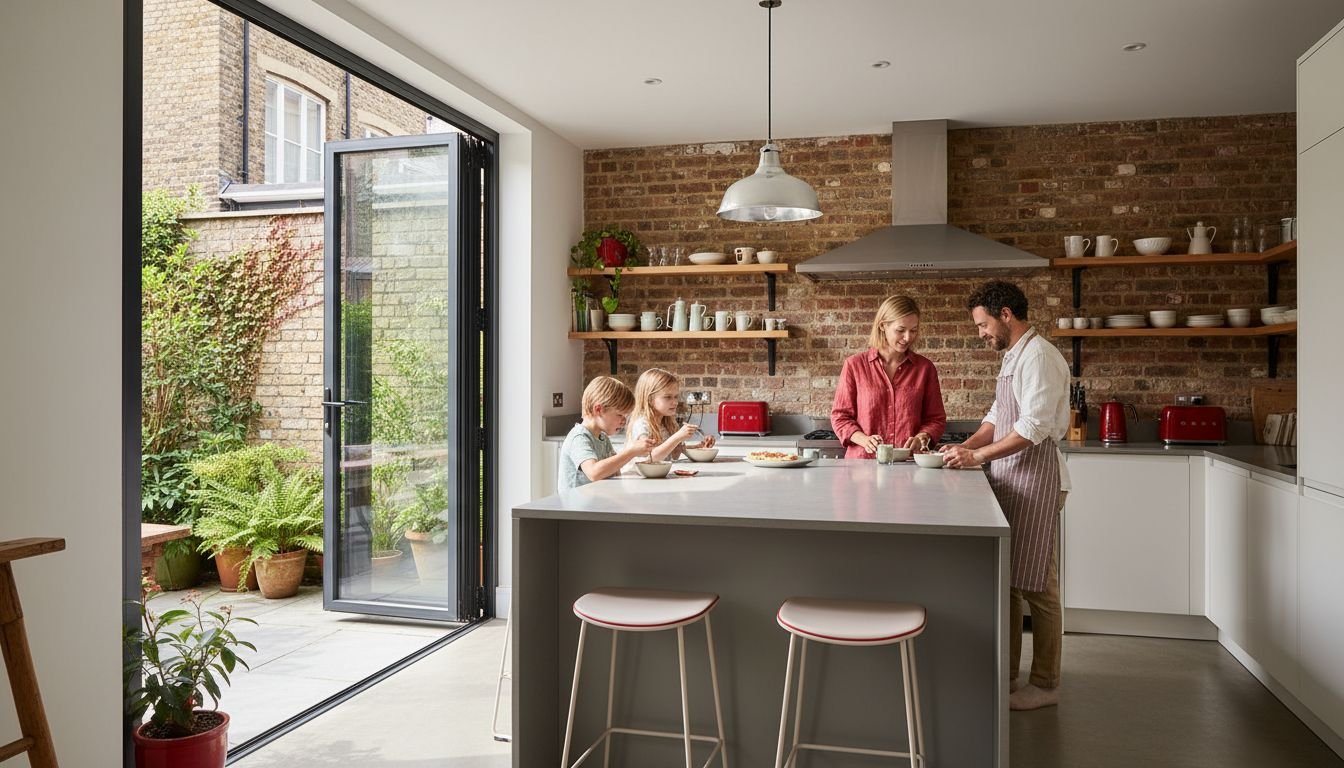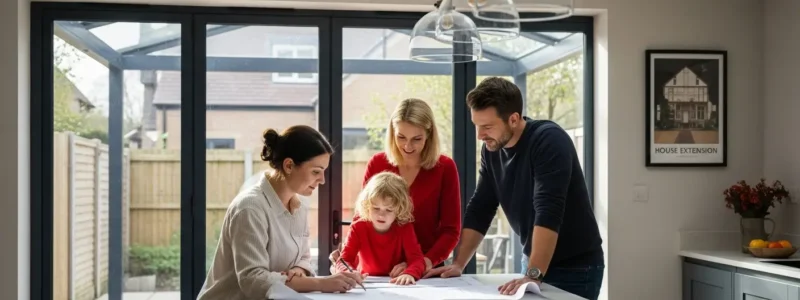Brighter kitchens do more than transform a home’s mood. Well-designed kitchen extensions can increase usable light by up to 40 percent, reshaping how you cook, dine, and relax. Homeowners across London are rethinking their spaces to improve natural light, boost family connection, and maximise every inch. If you’re planning a kitchen extension, discover smart ways to harness light, storage, and design so your new kitchen works beautifully for modern living.
Table of Contents
- Maximise Natural Light With Bifold Doors
- Create Open Plan Living For Family Space
- Utilise Smart Storage Solutions
- Choose Materials To Match London Properties
- Incorporate A Kitchen Island For Functionality
- Plan For Seamless Indoor-Outdoor Flow
- Understand Planning Permission And Building Rules
Quick Summary
| Takeaway | Explanation |
|---|---|
| 1. Maximize natural light with bifold doors | Bifold doors enhance natural lighting and create an indoor-outdoor flow, essential for spacious kitchens. |
| 2. Design open plan living for family engagement | Open plan designs promote connection, allowing for multifunctional spaces that adapt to family needs. |
| 3. Implement smart storage solutions | Innovative storage keeps kitchens organized and functional by intelligently integrating design and accessibility. |
| 4. Select materials that match architectural style | Choosing appropriate materials harmonizes your kitchen extension with your existing home, adding aesthetic and value. |
| 5. Understand planning permission requirements | Clear knowledge of legal regulations ensures compliance and avoids costly mistakes in your kitchen extension project. |
1. Maximise Natural Light with Bifold Doors
Transforming your kitchen extension with bifold doors is more than just an aesthetic upgrade its a strategic approach to reimagining your living space. These innovative glass doors create a seamless connection between your indoor kitchen and outdoor garden while flooding your interior with abundant natural light.
The strategic placement of bifold doors can dramatically change how sunlight moves through your kitchen. According to Vision Glass Doors, south-facing installations capture sunlight throughout the day, while north-facing doors provide gentler consistent illumination perfect for food preparation zones.
When selecting bifold doors for your London home, consider orientation carefully. East-southeast facing doors work exceptionally well in kitchen diners, providing natural light during morning and preparation hours without creating uncomfortable afternoon glare. Pro tip: pair your bifold doors with skylights to distribute light evenly across deeper extension spaces and eliminate shadowy corners.
Beyond lighting, bifold doors offer additional benefits. They create an illusion of expanded space by blurring indoor and outdoor boundaries. When fully opened, they transform your kitchen into an integrated indoor outdoor living area perfect for entertaining or enjoying quiet morning coffees.
Designing with light in mind means thinking about more than just glass panels. Consider external shading options for south-facing installations to prevent overheating during intense summer months. Subtle external blinds or strategically placed trees can help manage direct sunlight while maintaining your view and connection to the outdoors.
Implementation is key. Work with professionals who understand how to position and install bifold doors to maximise your specific property’s light potential. Every London home is unique and requires a tailored approach to truly unlock its natural light potential.
Quick Design Tip:
- Measure your space precisely
- Choose high quality double glazed panels
- Consider thermal efficiency alongside aesthetics
- Plan for both summer and winter light conditions
2. Create Open Plan Living for Family Space
Open plan living represents a modern approach to home design that transforms how families interact and utilise their living spaces. By breaking down traditional room barriers, you can create a dynamic multifunctional environment that promotes connection and flexibility.
According to Federation of Master Builders, contemporary home renovations are embracing open plan kitchens that combine dining and living areas without compromising on space or light. This design philosophy allows for a more informal and adaptable living experience that suits modern family dynamics.
Strategic Considerations for Open Plan Success
Creating an effective open plan space requires thoughtful design. The key is to maintain distinct functional zones while preserving an overall sense of unity. Consider using subtle architectural elements like changes in floor level, strategic furniture placement, or different flooring materials to define separate areas without constructing physical walls.
Noise and cooking smells can be potential challenges in open plan environments. Home Building suggests innovative solutions such as downdraught extractors and intelligent layout planning to manage these concerns effectively.
Practical Implementation Tips:
- Plan for clear sightlines between cooking and living zones
- Invest in high quality extraction systems
- Use multipurpose furniture that can define spaces
- Consider acoustic treatments to manage sound transmission
The beauty of open plan living lies in its ability to adapt to your familys changing needs. Whether youre preparing meals while supervising children or hosting dinner parties, this design approach offers unprecedented flexibility and connectivity.
3. Utilise Smart Storage Solutions
Storage is the unsung hero of any successful kitchen extension transforming cluttered spaces into sleek functional environments. Smart storage solutions are not just about hiding away items they are about creating an intelligent design that enhances your living experience.
According to Ideal Home, contemporary kitchen extensions benefit tremendously from strategic storage options that maintain both functionality and aesthetic appeal. Concealed storage areas for items like children’s art materials and recipe books can keep your space looking pristine while ensuring everything remains easily accessible.
Strategic Storage Placement
The key to exceptional storage lies in understanding your specific needs and designing solutions that seamlessly integrate with your kitchen’s layout. Uncommon Projects recommends positioning tall storage units between windows on internal walls. This approach maximises storage capacity without compromising the natural light that makes your extension feel spacious and welcoming.
Innovative Storage Strategies:
- Incorporate pull out pantry systems
- Use drawer dividers for utensil organisation
- Install floor to ceiling kitchen units
- Create hidden appliance stations
- Implement corner cabinet solutions
Think beyond traditional cabinetry. Modern storage solutions can include integrated charging stations built into drawers vertical pull out spice racks and modular units that adapt to your changing family needs. The goal is creating a kitchen that works smarter not harder helping you maintain an organised and stress free environment.
4. Choose Materials to Match London Properties
Selecting the right materials for your kitchen extension is about creating a harmonious dialogue between your homes existing architectural character and contemporary design aspirations. Your material choices can transform a simple renovation into a seamless architectural statement.
Uncommon Projects highlights the importance of balancing strong architectural features with a refined material palette particularly in North London period homes. This approach ensures your extension respects the historical context while introducing modern functionality.
Material Selection Strategies
London properties typically fall into distinct architectural categories Victorian terraced homes Edwardian properties post war builds and modern developments. Each demands a nuanced approach to material selection. For instance Victorian homes benefit from materials that reference traditional craftsmanship like marble worktops or handmade ceramic tiles while maintaining a contemporary edge.
Recommended Material Considerations:
- Match brick tones to existing property
- Select worktop materials complementing original architectural period
- Use neutral colour palettes with subtle texture variations
- Consider reclaimed or heritage inspired materials
- Prioritise durability alongside aesthetic appeal
Beyond visual harmony consider thermal performance and sustainability. Modern materials can provide superior insulation and energy efficiency while maintaining the aesthetic integrity of your London home. The goal is creating an extension that looks like it has always been part of your original property a true architectural chameleon.
5. Incorporate a Kitchen Island for Functionality
A kitchen island represents more than just additional counter space it is the central hub of modern family living. This versatile feature transforms your kitchen extension from a simple cooking area into a multifunctional social centre where food preparation meets family interaction.
According to Ideal Home, a well designed kitchen island can provide multiple functions. Imagine a space where children complete homework while you prepare dinner or a breakfast bar that creates an informal dining area. The addition of under island storage further maximises functionality by creating space for recipe books and crockery.
Design Considerations for Your Kitchen Island
Uncommon Projects emphasises the importance of designing a kitchen island that complements your homes architectural features. In period properties this means creating a central feature that respects the existing proportions while delivering modern practicality.
Strategic Island Planning:
- Measure your space carefully before design
- Consider multiple functional zones
- Choose materials matching existing kitchen aesthetic
- Plan for sufficient walking space around the island
- Integrate power outlets for added functionality
The key is viewing your kitchen island as an investment in family living. A thoughtfully designed island becomes more than furniture it becomes the heart of your home where memories are created meals are shared and connections are strengthened.
6. Plan for Seamless Indoor-Outdoor Flow
Creating a fluid connection between your kitchen and garden transforms how you experience your living space. A thoughtful indoor outdoor design turns your extension into a dynamic environment that breathes with natural light and expansive possibilities.
Bifold Shop highlights the transformative power of installing bifold doors in kitchen extensions. These innovative doors create an expansive feel allowing you to open your entire kitchen to the garden during summer months bringing the outdoors directly into your cooking and dining areas.
Designing for Connectivity
The secret to a successful indoor outdoor flow lies in careful planning. Consider floor levels materials and visual lines that create a seamless transition. Matching indoor and outdoor flooring materials or using similar colour palettes can help blur the boundaries between interior and exterior spaces.
Strategic Design Considerations:
- Choose wide glass door configurations
- Select matching or complementary floor materials
- Create a consistent colour palette inside and outside
- Plan for external seating that connects to interior space
- Consider level thresholds to reduce visual interruption
Think of your kitchen extension as more than a room. It is a dynamic interface between your home and garden a space that adapts to seasons invites natural light and expands your living experience beyond traditional architectural boundaries.
7. Understand Planning Permission and Building Rules
Navigating the complex landscape of planning permissions and building regulations is crucial for any successful kitchen extension project. Understanding these legal requirements protects your investment and ensures your home improvement meets all necessary standards.
According to Epping Town Council, local councils require specific approvals for home extensions. Applications often need careful preparation especially for modifications like adding front canopies boundary walls or new structural elements.
Key Regulatory Considerations
Home Building emphasises that understanding regulations goes beyond mere legal compliance. Your extension design must harmonise with existing property structures while meeting safety and structural integrity standards.
Critical Planning Permission Steps:
- Check permitted development rights for your property
- Consult local council planning department
- Prepare detailed architectural drawings
- Consider potential restrictions in conservation areas
- Budget for potential professional consultation fees
Remember that each London borough has unique regulatory nuances. While general guidelines exist professional advice can help you navigate specific local requirements and avoid potential costly mistakes during your kitchen extension journey.
This table summarises key strategies for enhancing kitchen extensions, including maximising natural light, adopting open plan living, integrating smart storage, selecting appropriate materials, utilising kitchen islands, ensuring seamless indoor-outdoor flow, and understanding planning permissions.
| Topic | Description | Key Considerations |
|---|---|---|
| Maximising Natural Light | Use bifold doors to increase natural light and create a seamless indoor-outdoor connection. | Consider door orientation, pair with skylights, and use external shading for sun management. |
| Open Plan Living | Modern approach removing barriers for multifunctional spaces. | Maintain functional zones, manage noise and smells, and use multipurpose furniture. |
| Smart Storage Solutions | Transform cluttered spaces with intelligent design. | Use pull-out systems, hidden appliances, and modular units. |
| Material Selection | Match home architectural character with suitable materials. | Consider period styles, visual harmony, and thermal performance. |
| Kitchen Island Functionality | Central hub for social and practical purposes. | Design for multiple uses, include storage, and ensure it complements home features. |
| Seamless Indoor-Outdoor Flow | Connects kitchen to garden for expanded living experience. | Match flooring materials and use wide glass doors for visual continuity. |
| Planning Permissions | Essential for legal compliance and design harmony. | Check local regulations, prepare detailed plans, and consult professionals. |
Unlock the Full Potential of Your London Kitchen Extension
If you are inspired by ideas like maximising natural light with bifold doors or creating seamless indoor outdoor flow, but feel overwhelmed by how to bring them together in your London home, you are not alone. Many homeowners struggle to balance design creativity with practical challenges like planning permissions and tailored storage solutions. At Reltic Extend, we understand these concerns and specialise in turning your kitchen extension dreams into reality with over 20 years of trusted experience and a proven focus on quality.
Explore our Design & Build Tips for Home Extensions to get expert advice on creating multifunctional spaces and choosing the right materials. Delve into various Types of Home Extensions & Ideas for inspiration tailored to London properties. Ready to make your bespoke rear kitchen extension project seamless and stress free Contact us today at Reltic Extend to start with a transparent plan and expert management that ensures timely delivery within budget. Let’s transform your kitchen into the vibrant heart of your home now.
Frequently Asked Questions
How can I maximize natural light in my rear kitchen extension?
To maximize natural light, consider installing bifold doors that open up to your garden. Additionally, you could add skylights to distribute light evenly, especially in deeper spaces.
What layout works best for an open plan kitchen extension?
An effective layout for an open plan kitchen is to maintain clear sightlines between cooking and living areas while using subtle architectural elements to define separate zones. Measure your space carefully and plan for multipurpose furniture to enhance functionality.
What are some smart storage solutions for a kitchen extension?
Incorporate pull-out pantry systems, drawer dividers, and hidden appliance stations to optimize space and maintain organization in your kitchen extension. Aim to utilize every inch of available space creatively to keep your kitchen clutter-free and functional.
Which materials should I choose for my London kitchen extension?
Choose materials that harmonize with the existing architectural style of your home, such as marble worktops for Victorian properties. Focus on durability and a cohesive color palette that matches the original structure.
What should I consider when planning for an indoor-outdoor flow?
Plan for seamless indoor-outdoor flow by using matching flooring materials and minimizing visual interruptions with level thresholds. Consider wide glass door configurations and consistent color palettes to enhance connectivity between spaces.
How do I understand and navigate planning permissions for my extension?
Start by checking your property’s permitted development rights and consulting with your local planning department. Prepare detailed architectural drawings to comply with local regulations and ensure your design integrates safely with existing structures.





